PA 206 Acountability and Ethics in Public Administration.pptx
Download as pptx, pdf0 likes16 views
This document does not contain any substantive information to summarize. It consists entirely of bullet point markers without any accompanying text or details. Therefore, no meaningful high-level summary can be provided in 3 sentences or less.
1 of 34
Download to read offline
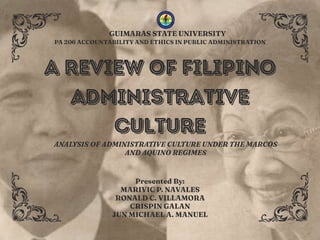
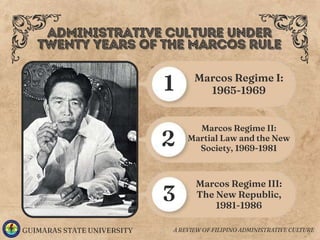
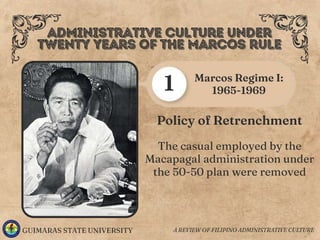
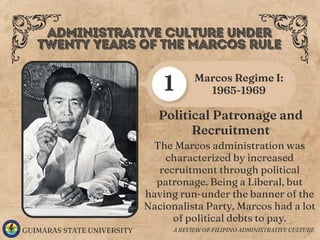
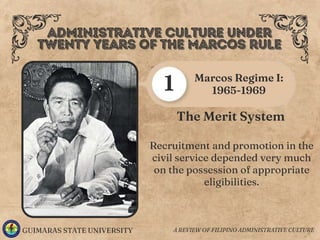
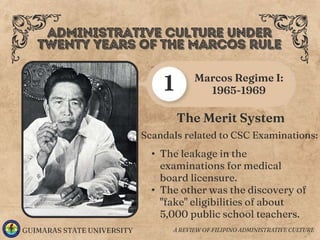


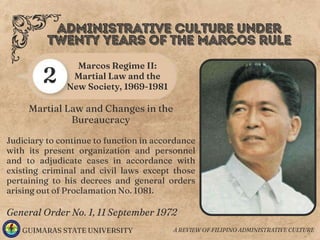
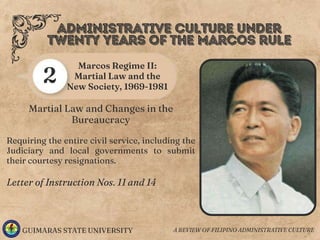
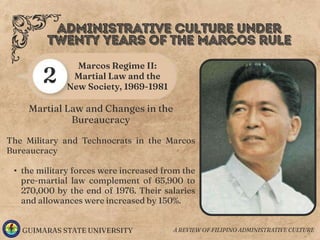


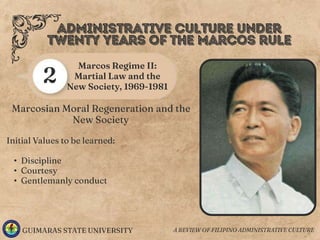
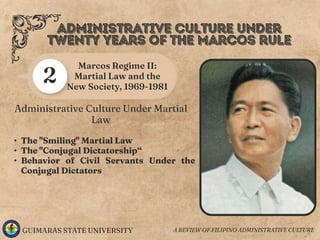

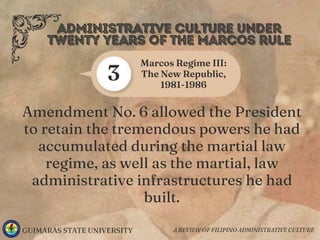

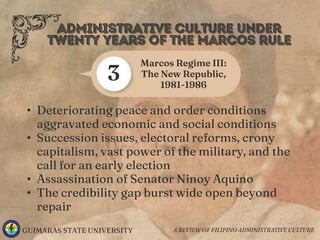


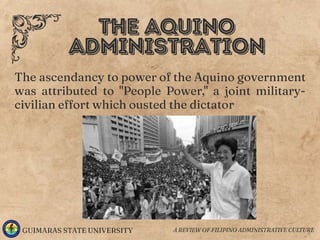
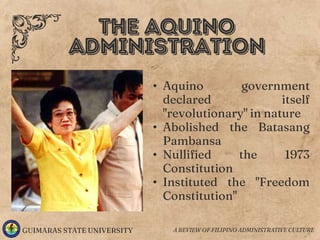
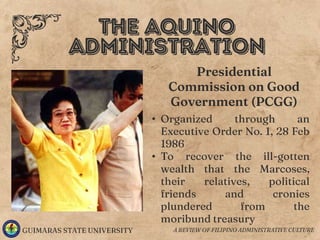
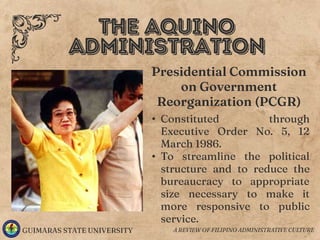
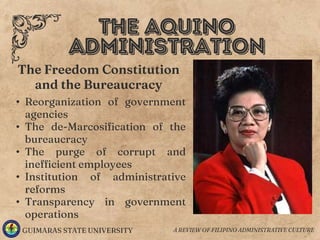
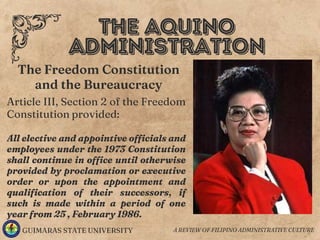

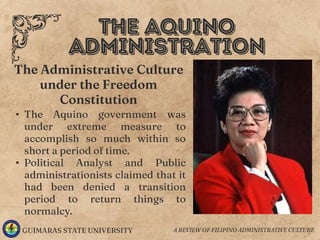
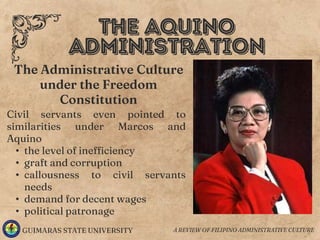
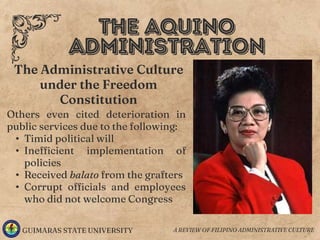
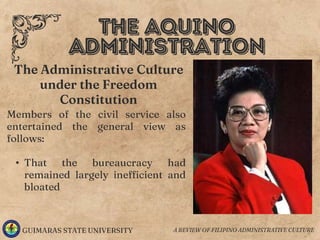
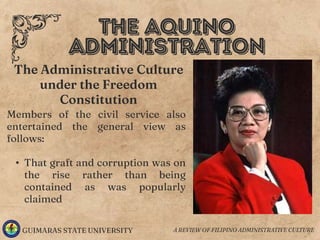

Ad
Recommended
Group 9 - PA 207 Decentralization and Local Autonomy final-revised.pptx
Group 9 - PA 207 Decentralization and Local Autonomy final-revised.pptxMarivicPenarubia1
Ěý
The document discusses decentralization and local autonomy in the Philippines. It covers topics such as basic processes of organization, centralism, the concepts of local autonomy and decentralization, decentralization efforts over past decades from 1898 to present, current decentralization initiatives including the Local Government Code of 1991, and case studies on the state of devolution.397561808.pdf
397561808.pdfMarivicPenarubia1
Ěý
This document discusses concepts related to conflict management in the workplace. It covers topics such as causes of workplace conflict, types of conflict, effects of conflict, and approaches to conflict management. Specifically:
1. Workplace conflict can arise due to differences of opinion, priorities, personalities, and resources. Managers' actions like poor communication can also cause conflicts.
2. Conflict can be constructive when it helps address problems, or destructive when it hinders progress and damages relationships.
3. Conflict management aims to limit negative aspects of conflict while increasing positive aspects. Resolving conflicts properly depends on the environment created by managers.Group 5 - Culture and Environment1.pptx
Group 5 - Culture and Environment1.pptxMarivicPenarubia1
Ěý
This document is a presentation by Group 5 from Guimaras State University on culture and environment. It discusses the meaning of culture, the different parts and layers of culture, how culture manifests through symbols, heroes and rituals, and different theories of culture. It also covers how values change between generations from the Silents to Millennials. The presentation concludes with environmental best practices for waste disposal, reducing plastic and paper use, and building a more sustainable future. PA-210-G1-Participatory Project Development Management.pdf
PA-210-G1-Participatory Project Development Management.pdfMarivicPenarubia1
Ěý
This document discusses participatory project development management. It covers topics such as defining the scope and nature of projects, raising productivity levels, and broadening participation in projects. The scope of a project involves determining goals, deliverables, tasks, costs and deadlines. Defining the scope is important for planning and managing projects. Productivity can be increased by establishing clear objectives, communicating them effectively, involving stakeholders in decision making, and providing training. The document provides details on each of these topics over several pages.Group-2-EVOLUTION-OF-PUBLIC-ADMINISTRATION-THEORIES-AND-PRACTICES-TABLADELLO-...
Group-2-EVOLUTION-OF-PUBLIC-ADMINISTRATION-THEORIES-AND-PRACTICES-TABLADELLO-...MarivicPenarubia1
Ěý
This document discusses the evolution of public administration theories and practices. It covers the development of public administration and three main theories: Classical Public Administration Theory, New Public Management Theory, and Postmodern Public Administration Theory. It also describes six paradigms of traditional public administration models and how public administration has taken on new roles in modern society, including designing policy, implementing policy, and serving as an agent of change.Group-8-PA-204-G8-theory-and-practice-in-public-administration.pdf
Group-8-PA-204-G8-theory-and-practice-in-public-administration.pdfMarivicPenarubia1
Ěý
The document discusses current issues and trends in public administration, including increased digital governance due to the COVID-19 pandemic forcing many agencies to adopt digital services. Other trends discussed are improved data management, anticipatory public services, comprehensive cybersecurity, diversity and inclusion, flexible remote workplaces, agile administration, and rebuilding government trust. The pandemic highlighted the need for flexibility and adaptability within governance systems.Group-9-PUBLIC-SERVICE-MODERNIZATION.pdf
Group-9-PUBLIC-SERVICE-MODERNIZATION.pdfMarivicPenarubia1
Ěý
The document discusses gender values and women's empowerment in the Philippine bureaucracy. It outlines key provisions and rights established by the Magna Carta of Women (MCW), including the right to protection from violence, participation in decision-making, equal treatment before the law, and rights to health, education, livelihood and social protection. The MCW aims to eliminate discrimination against women and promote substantive gender equality. The Philippine government has also undertaken initiatives to modernize public service delivery through e-governance and increasing access to information and communication technologies.PA-203-Topics-1-3 v2.pptx
PA-203-Topics-1-3 v2.pptxMarivicPenarubia1
Ěý
This document discusses man's relationship with nature and various environmental issues. It begins by explaining how humans depend on nature for basic needs like food, water and shelter. It then outlines different perspectives on man's role in the environment like anthropocentrism, biocentrism and ecocentrism. The document also examines how humans have impacted the environment through changes in lifestyle from the past to present regarding housing, transportation, agriculture, industry and more. Specific issues covered include pollution, climate change, loss of biodiversity and overconsumption of natural resources. The document emphasizes the importance of environmental education in encouraging sustainable practices.PA- 210-G5-Preparing of Project Proposal and other Related needs for the Impl...
PA- 210-G5-Preparing of Project Proposal and other Related needs for the Impl...MarivicPenarubia1
Ěý
This document outlines the steps for preparing project proposals and implementing development projects in the Philippines. It discusses preparing a project proposal, follow up work for approval, and planning implementation. Preparing a proposal involves defining the problem, presenting a solution, outlining deliverables and success criteria, stating the plan and schedule/budget. Follow up ensures projects meet objectives and builds accountability. Planning implementation requires defining goals, conducting research, mapping risks, assigning tasks, and allocating resources. The overall goal is to effectively develop and oversee projects to improve economic and social conditions.PA-210-G1-Participatory Project Development Management.pptx
PA-210-G1-Participatory Project Development Management.pptxMarivicPenarubia1
Ěý
This document discusses participatory project development management. It covers topics such as the scope and nature of projects, raising productivity levels, and broadening project benefits. The scope section defines project scope, explains why it is important, and outlines the key steps and areas of a project plan. It also describes the nature and five stages of project management. The productivity section discusses definitions of productivity and effectiveness/efficiency. It provides seven cornerstones for high productivity, including establishing clear objectives, communicating objectives effectively, and consensus decision making.PA-210-G2-Community-Organizing.ppt
PA-210-G2-Community-Organizing.pptMarivicPenarubia1
Ěý
Community organizing aims to empower individuals and build organizations for social change. It has historically focused on building social movements in small communities. Saul Alinsky developed influential community organizing principles in the 1930s-1940s emphasizing democratic decision making, indigenous leadership, and addressing people's self-interest. Community organizing is a process where people address common issues, take collective action, and work to increase influence over policies affecting their lives. It ultimately aims to allow people more control over their own circumstances. Effective community organizing follows steps including entering a community, integrating with residents, analyzing issues, developing leaders, and strengthening community organizations.PA-210-G4-PROJECT-DEVELOPMENT-CYCLE.pptx
PA-210-G4-PROJECT-DEVELOPMENT-CYCLE.pptxMarivicPenarubia1
Ěý
The document outlines the key stages in a typical project development cycle. It discusses (1) project identification which involves reviewing alternative approaches and defining objectives and scope, (2) project prioritization which enables governments to choose the right projects based on rigorous evaluation, and (3) using a logical framework and log frame to summarize the project plan hierarchy and objectives. It also covers market analysis, financial analysis, organizational structure and management functions involved in planning, organizing, staffing, leading and controlling a project.PA-210-G6-PROJECT-IMPLEMENTATION-AND-MANAGEMENT-TOWARDS-SUSTAINING-AND-STRENG...
PA-210-G6-PROJECT-IMPLEMENTATION-AND-MANAGEMENT-TOWARDS-SUSTAINING-AND-STRENG...MarivicPenarubia1
Ěý
This document discusses project implementation and management in three parts:
1. It introduces project implementation as the phase where plans become reality, and defines project management as planning and organizing resources to complete tasks.
2. It explains that in the Philippines, the government is working to efficiently monitor and evaluate projects through bodies like regional development councils.
3. It outlines steps for organizing a project's implementation, including creating a plan, schedule, and priorities, using project management software, communicating well, and regularly measuring progress.PA-210-G3-PROJECT.pptx
PA-210-G3-PROJECT.pptxMarivicPenarubia1
Ěý
This document discusses different types of projects including their elements, ingredients, functions, sectors, and purposes. It distinguishes between sustainable versus non-sustainable projects and service versus product projects. Sustainable projects meet current needs without compromising future generations' ability to meet their own needs. They consider environmental, social, and economic factors. Non-sustainable projects exceed the ecosystem's ability to replenish resources over time, harming environments and futures. The document also defines products as tangible items for acquisition and services as intangible outputs from individuals.PA 210.pptx
PA 210.pptxMarivicPenarubia1
Ěý
The document discusses monitoring and evaluation of projects in the Philippines. It provides the legal basis for project monitoring committees established by executive orders and memorandums. These committees monitor projects at regional, provincial and municipal levels. The document also describes the Duterte administration's socio-economic agenda and reforms. It defines monitoring and evaluation, and explains their purpose is to assess results, improve management, promote learning, and ensure accountability. Finally, it outlines the key steps for effective project monitoring and evaluation.Pa-203-Green-education.pptx
Pa-203-Green-education.pptxMarivicPenarubia1
Ěý
This document discusses the meaning and components of culture. It defines culture as the knowledge, beliefs, arts, morals, laws, and customs acquired by people as members of society. Culture is divided into material and non-material aspects. Material culture refers to physical objects, while non-material culture consists of ideas, beliefs, values, and institutions. Culture manifests through symbols, heroes, rituals, and core values. The document also discusses several theories related to culture, including cultural determinism, cultural relativism, and cultural ethnocentrism.FINAL-ENVIRONMENTAL-AWARENESS-environmental-education-school-curriculum-PPT-P...
FINAL-ENVIRONMENTAL-AWARENESS-environmental-education-school-curriculum-PPT-P...MarivicPenarubia1
Ěý
The document discusses environmental awareness and education. It notes that environmental awareness involves purposefully influencing attitudes and behaviors around environmental issues. It also discusses several events to promote environmental awareness, including World Environment Day on June 5th and Earth Day on April 22nd. The document then covers environmental education in schools, noting that it aims to increase awareness of issues and empower students to engage in problem solving and decision making around the environment. It also discusses teaching students to be environmental stewards and using service learning to promote positive environmental action.MPA Reporting.pptx
MPA Reporting.pptxMarivicPenarubia1
Ěý
The document discusses New Public Management (NPM), which seeks to implement flexibility, transparency, minimal government, and privatization in public administration. NPM applies principles of efficiency and economy from the private sector to make public sectors more effective. It focuses on being flexible, change-oriented, and client-oriented rather than rigid, maintaining the status quo, and profit-oriented like Old Public Administration. Key principles of NPM include emphasizing economy, efficiency and effectiveness; reorganizing bureaucracies; increasing competition; reducing expenses; and emphasizing private-sector styles of management. The New Public Administration transformed public administration to be more socially conscious and brought qualitative change by reducing bureaucratic red tape in developing countries.Group-1-PA204_PUBLIC-ADMINISTRATION-AND-MANAGEMENT_AN-INTRODUCTION-1.pdf
Group-1-PA204_PUBLIC-ADMINISTRATION-AND-MANAGEMENT_AN-INTRODUCTION-1.pdfMarivicPenarubia1
Ěý
This document provides an overview of key topics in public administration, including:
1. Definitions and introductions of public administration, management, and politics. Public administration is the implementation of government policy, while management involves overseeing people and resources to achieve goals. Politics is concerned with controlling government.
2. Concepts of public administration like its focus on fulfilling public policy. New concepts emphasize flexible structures and efficiency.
3. Principles of public administration in the Philippines like transparency, equity, and accountability. Major institutions that practice it include education, government, and politics.
4. Differences between public and private administration, such as their setup, decision making approaches, motives, and accountability. Public administration serves430397485-Theories-in-Public-Administration.pptx
430397485-Theories-in-Public-Administration.pptxMarivicPenarubia1
Ěý
Classical public administration focused on running government like a business with clear hierarchies and standard operating procedures. New public management emerged later treating citizens as customers and importing private sector management techniques. Postmodern public administration rejects the idea of one universal approach and instead emphasizes relativity, inclusion, and addressing social inequities.asgfgfghgvb.pptx
asgfgfghgvb.pptxMarivicPenarubia1
Ěý
The document outlines the agenda for a quarterly meeting taking place from 8:00 AM to 5:00 PM at the Zuri Hotel in Iloilo City on June 24, 2022. The agenda includes presentations from various departments on topics such as the PAS, HRPPMS, and HR Welfare from 9:00 AM to 3:00 PM, followed by a sharing of the competency-based HR system and directions for the second semester of 2022. The document lists the meeting's time and location and provides an agenda with timing for each scheduled presentation and activity.MPA Reporting.pptx
MPA Reporting.pptxMarivicPenarubia1
Ěý
The document discusses the emergence of New Public Management (NPM) as an alternative to Old Public Administration in the 1980s. NPM seeks to build administration through flexibility, transparency, minimal government, decentralization, and market-oriented and privatized public services. It focuses on being flexible, change-oriented, and client-oriented rather than rigid, maintaining the status quo, and profit-oriented. The key principles of NPM emphasize economy, efficiency, effectiveness, reorganizing bureaucracies, increasing competition and shifting to private-sector styles of management.MPA Reporting - Copy.pptx
MPA Reporting - Copy.pptxMarivicPenarubia1
Ěý
This document discusses the key principles and features of New Public Management (NPM). It notes that NPM focuses on flexibility over bureaucratic structure, believes public administration will change with socioeconomic changes, and is client-oriented by focusing on services to people. The main principles outlined are emphasizing economy, efficiency and effectiveness; reorganizing bureaucracy; increasing competition; reducing expenses; and shifting to greater private-sector styles of management. Features include citizen empowerment, decentralization, restructuring government, goal-orientation, cost-cutting, and better services. The anti-goals of NPM are said to be anti-hierarchical and anti-technical, rejecting technical analysis and strict hierarchies. In conclusion, NPM is said to havePre deployment Orientation_HRPPMS.pptx
Pre deployment Orientation_HRPPMS.pptxMarivicPenarubia1
Ěý
The document outlines the recruitment, selection, and personnel policies and procedures of the Department of Social Welfare and Development Field Office VI in Iloilo City, Philippines. It discusses DSWD's commitment to merit-based hiring and equal treatment of employees regardless of attributes. It also establishes guidelines regarding employee conduct, transparency, confidentiality, conflicts of interest, post-employment restrictions, nepotism, and acceptance of gifts. The policies aim to ensure integrity, fairness and ethical behavior across the Department.GROUP-2-EVOLUTION-OF-PUBLIC-ADMINISTRATION-THEORIES-AND-PRACTICES-TABLADELLO-...
GROUP-2-EVOLUTION-OF-PUBLIC-ADMINISTRATION-THEORIES-AND-PRACTICES-TABLADELLO-...MarivicPenarubia1
Ěý
This document discusses the evolution of public administration theories and practices. It covers the development of public administration and three main theories: Classical Public Administration Theory, New Public Management Theory, and Postmodern Public Administration Theory. It also describes six paradigms of traditional public administration models and how public administration has taken on new roles in modern society, including designing policy, implementing policy, and serving as a change agent.Mtg with DC Presetation Presentation.pptx
Mtg with DC Presetation Presentation.pptxMarivicPenarubia1
Ěý
The Human Resource Planning and Performance Management Section ensures proper implementation of staffing policies including recruitment, selection, and performance appraisal. It is currently working on ongoing selection processes, establishing pre-deployment orientation, processing transfer and resignation requests, and facilitating assessments. Upcoming activities include periodic meetings, preparing for ISO and accreditation certification. Issues include hiring concerns, deployment processes, and office space limitations. Ways forward include information dissemination, staff capacitation, training, establishing hiring guidelines, and improving application reply systems.310ch5.pdf
310ch5.pdfMarivicPenarubia1
Ěý
This document provides instructions for operating a Furuno Heavy-Duty High Performance Raster Scan Radar and ARPA Model FR/FAR-28x5 series. It describes the key features of the radar, including a 28-inch display, target detection enhancements, guard zone alarms, and electronic plotting capabilities. The document outlines how to turn on the power, transmit radar pulses, tune the receiver, and use various display controls and menus. It also explains functions like on-screen legends, data display, and manual degaussing of the CRT screen.SCHIZOPHRENIA OTHER PSYCHOTIC DISORDER LIKE Persistent delusion/Capgras syndr...
SCHIZOPHRENIA OTHER PSYCHOTIC DISORDER LIKE Persistent delusion/Capgras syndr...parmarjuli1412
Ěý
SCHIZOPHRENIA INCLUDED TOPIC IS INTRODUCTION, DEFINITION OF GENERAL TERM IN PSYCHIATRIC, THEN DIFINITION OF SCHIZOPHRENIA, EPIDERMIOLOGY, ETIOLOGICAL FACTORS, CLINICAL FEATURE(SIGN AND SYMPTOMS OF SCHIZOPHRENIA), CLINICAL TYPES OF SCHIZOPHRENIA, DIAGNOSIS, INVESTIGATION, TREATMENT MODALITIES(PHARMACOLOGICAL MANAGEMENT, PSYCHOTHERAPY, ECT, PSYCHO-SOCIO-REHABILITATION), NURSING MANAGEMENT(ASSESSMENT,DIAGNOSIS,NURSING INTERVENTION,AND EVALUATION), OTHER PSYCHOTIC DISORDER LIKE Persistent delusion/Capgras syndrome(The Delusion of Doubles)/Acute and Transient Psychotic Disorders/Induced Delusional Disorders/Schizoaffective Disorder /CAPGRAS SYNDROME(DELUSION OF DOUBLE), GERIATRIC CONSIDERATION, FOLLOW UP, HOMECARE AND REHABILITATION OF THE PATIENT, Q1_ENGLISH_PPT_WEEK 1 power point grade 3 Quarter 1 week 1
Q1_ENGLISH_PPT_WEEK 1 power point grade 3 Quarter 1 week 1jutaydeonne
Ěý
Grade 3 Quarter 1 Week 1 English part 2More Related Content
More from MarivicPenarubia1 (19)
PA- 210-G5-Preparing of Project Proposal and other Related needs for the Impl...
PA- 210-G5-Preparing of Project Proposal and other Related needs for the Impl...MarivicPenarubia1
Ěý
This document outlines the steps for preparing project proposals and implementing development projects in the Philippines. It discusses preparing a project proposal, follow up work for approval, and planning implementation. Preparing a proposal involves defining the problem, presenting a solution, outlining deliverables and success criteria, stating the plan and schedule/budget. Follow up ensures projects meet objectives and builds accountability. Planning implementation requires defining goals, conducting research, mapping risks, assigning tasks, and allocating resources. The overall goal is to effectively develop and oversee projects to improve economic and social conditions.PA-210-G1-Participatory Project Development Management.pptx
PA-210-G1-Participatory Project Development Management.pptxMarivicPenarubia1
Ěý
This document discusses participatory project development management. It covers topics such as the scope and nature of projects, raising productivity levels, and broadening project benefits. The scope section defines project scope, explains why it is important, and outlines the key steps and areas of a project plan. It also describes the nature and five stages of project management. The productivity section discusses definitions of productivity and effectiveness/efficiency. It provides seven cornerstones for high productivity, including establishing clear objectives, communicating objectives effectively, and consensus decision making.PA-210-G2-Community-Organizing.ppt
PA-210-G2-Community-Organizing.pptMarivicPenarubia1
Ěý
Community organizing aims to empower individuals and build organizations for social change. It has historically focused on building social movements in small communities. Saul Alinsky developed influential community organizing principles in the 1930s-1940s emphasizing democratic decision making, indigenous leadership, and addressing people's self-interest. Community organizing is a process where people address common issues, take collective action, and work to increase influence over policies affecting their lives. It ultimately aims to allow people more control over their own circumstances. Effective community organizing follows steps including entering a community, integrating with residents, analyzing issues, developing leaders, and strengthening community organizations.PA-210-G4-PROJECT-DEVELOPMENT-CYCLE.pptx
PA-210-G4-PROJECT-DEVELOPMENT-CYCLE.pptxMarivicPenarubia1
Ěý
The document outlines the key stages in a typical project development cycle. It discusses (1) project identification which involves reviewing alternative approaches and defining objectives and scope, (2) project prioritization which enables governments to choose the right projects based on rigorous evaluation, and (3) using a logical framework and log frame to summarize the project plan hierarchy and objectives. It also covers market analysis, financial analysis, organizational structure and management functions involved in planning, organizing, staffing, leading and controlling a project.PA-210-G6-PROJECT-IMPLEMENTATION-AND-MANAGEMENT-TOWARDS-SUSTAINING-AND-STRENG...
PA-210-G6-PROJECT-IMPLEMENTATION-AND-MANAGEMENT-TOWARDS-SUSTAINING-AND-STRENG...MarivicPenarubia1
Ěý
This document discusses project implementation and management in three parts:
1. It introduces project implementation as the phase where plans become reality, and defines project management as planning and organizing resources to complete tasks.
2. It explains that in the Philippines, the government is working to efficiently monitor and evaluate projects through bodies like regional development councils.
3. It outlines steps for organizing a project's implementation, including creating a plan, schedule, and priorities, using project management software, communicating well, and regularly measuring progress.PA-210-G3-PROJECT.pptx
PA-210-G3-PROJECT.pptxMarivicPenarubia1
Ěý
This document discusses different types of projects including their elements, ingredients, functions, sectors, and purposes. It distinguishes between sustainable versus non-sustainable projects and service versus product projects. Sustainable projects meet current needs without compromising future generations' ability to meet their own needs. They consider environmental, social, and economic factors. Non-sustainable projects exceed the ecosystem's ability to replenish resources over time, harming environments and futures. The document also defines products as tangible items for acquisition and services as intangible outputs from individuals.PA 210.pptx
PA 210.pptxMarivicPenarubia1
Ěý
The document discusses monitoring and evaluation of projects in the Philippines. It provides the legal basis for project monitoring committees established by executive orders and memorandums. These committees monitor projects at regional, provincial and municipal levels. The document also describes the Duterte administration's socio-economic agenda and reforms. It defines monitoring and evaluation, and explains their purpose is to assess results, improve management, promote learning, and ensure accountability. Finally, it outlines the key steps for effective project monitoring and evaluation.Pa-203-Green-education.pptx
Pa-203-Green-education.pptxMarivicPenarubia1
Ěý
This document discusses the meaning and components of culture. It defines culture as the knowledge, beliefs, arts, morals, laws, and customs acquired by people as members of society. Culture is divided into material and non-material aspects. Material culture refers to physical objects, while non-material culture consists of ideas, beliefs, values, and institutions. Culture manifests through symbols, heroes, rituals, and core values. The document also discusses several theories related to culture, including cultural determinism, cultural relativism, and cultural ethnocentrism.FINAL-ENVIRONMENTAL-AWARENESS-environmental-education-school-curriculum-PPT-P...
FINAL-ENVIRONMENTAL-AWARENESS-environmental-education-school-curriculum-PPT-P...MarivicPenarubia1
Ěý
The document discusses environmental awareness and education. It notes that environmental awareness involves purposefully influencing attitudes and behaviors around environmental issues. It also discusses several events to promote environmental awareness, including World Environment Day on June 5th and Earth Day on April 22nd. The document then covers environmental education in schools, noting that it aims to increase awareness of issues and empower students to engage in problem solving and decision making around the environment. It also discusses teaching students to be environmental stewards and using service learning to promote positive environmental action.MPA Reporting.pptx
MPA Reporting.pptxMarivicPenarubia1
Ěý
The document discusses New Public Management (NPM), which seeks to implement flexibility, transparency, minimal government, and privatization in public administration. NPM applies principles of efficiency and economy from the private sector to make public sectors more effective. It focuses on being flexible, change-oriented, and client-oriented rather than rigid, maintaining the status quo, and profit-oriented like Old Public Administration. Key principles of NPM include emphasizing economy, efficiency and effectiveness; reorganizing bureaucracies; increasing competition; reducing expenses; and emphasizing private-sector styles of management. The New Public Administration transformed public administration to be more socially conscious and brought qualitative change by reducing bureaucratic red tape in developing countries.Group-1-PA204_PUBLIC-ADMINISTRATION-AND-MANAGEMENT_AN-INTRODUCTION-1.pdf
Group-1-PA204_PUBLIC-ADMINISTRATION-AND-MANAGEMENT_AN-INTRODUCTION-1.pdfMarivicPenarubia1
Ěý
This document provides an overview of key topics in public administration, including:
1. Definitions and introductions of public administration, management, and politics. Public administration is the implementation of government policy, while management involves overseeing people and resources to achieve goals. Politics is concerned with controlling government.
2. Concepts of public administration like its focus on fulfilling public policy. New concepts emphasize flexible structures and efficiency.
3. Principles of public administration in the Philippines like transparency, equity, and accountability. Major institutions that practice it include education, government, and politics.
4. Differences between public and private administration, such as their setup, decision making approaches, motives, and accountability. Public administration serves430397485-Theories-in-Public-Administration.pptx
430397485-Theories-in-Public-Administration.pptxMarivicPenarubia1
Ěý
Classical public administration focused on running government like a business with clear hierarchies and standard operating procedures. New public management emerged later treating citizens as customers and importing private sector management techniques. Postmodern public administration rejects the idea of one universal approach and instead emphasizes relativity, inclusion, and addressing social inequities.asgfgfghgvb.pptx
asgfgfghgvb.pptxMarivicPenarubia1
Ěý
The document outlines the agenda for a quarterly meeting taking place from 8:00 AM to 5:00 PM at the Zuri Hotel in Iloilo City on June 24, 2022. The agenda includes presentations from various departments on topics such as the PAS, HRPPMS, and HR Welfare from 9:00 AM to 3:00 PM, followed by a sharing of the competency-based HR system and directions for the second semester of 2022. The document lists the meeting's time and location and provides an agenda with timing for each scheduled presentation and activity.MPA Reporting.pptx
MPA Reporting.pptxMarivicPenarubia1
Ěý
The document discusses the emergence of New Public Management (NPM) as an alternative to Old Public Administration in the 1980s. NPM seeks to build administration through flexibility, transparency, minimal government, decentralization, and market-oriented and privatized public services. It focuses on being flexible, change-oriented, and client-oriented rather than rigid, maintaining the status quo, and profit-oriented. The key principles of NPM emphasize economy, efficiency, effectiveness, reorganizing bureaucracies, increasing competition and shifting to private-sector styles of management.MPA Reporting - Copy.pptx
MPA Reporting - Copy.pptxMarivicPenarubia1
Ěý
This document discusses the key principles and features of New Public Management (NPM). It notes that NPM focuses on flexibility over bureaucratic structure, believes public administration will change with socioeconomic changes, and is client-oriented by focusing on services to people. The main principles outlined are emphasizing economy, efficiency and effectiveness; reorganizing bureaucracy; increasing competition; reducing expenses; and shifting to greater private-sector styles of management. Features include citizen empowerment, decentralization, restructuring government, goal-orientation, cost-cutting, and better services. The anti-goals of NPM are said to be anti-hierarchical and anti-technical, rejecting technical analysis and strict hierarchies. In conclusion, NPM is said to havePre deployment Orientation_HRPPMS.pptx
Pre deployment Orientation_HRPPMS.pptxMarivicPenarubia1
Ěý
The document outlines the recruitment, selection, and personnel policies and procedures of the Department of Social Welfare and Development Field Office VI in Iloilo City, Philippines. It discusses DSWD's commitment to merit-based hiring and equal treatment of employees regardless of attributes. It also establishes guidelines regarding employee conduct, transparency, confidentiality, conflicts of interest, post-employment restrictions, nepotism, and acceptance of gifts. The policies aim to ensure integrity, fairness and ethical behavior across the Department.GROUP-2-EVOLUTION-OF-PUBLIC-ADMINISTRATION-THEORIES-AND-PRACTICES-TABLADELLO-...
GROUP-2-EVOLUTION-OF-PUBLIC-ADMINISTRATION-THEORIES-AND-PRACTICES-TABLADELLO-...MarivicPenarubia1
Ěý
This document discusses the evolution of public administration theories and practices. It covers the development of public administration and three main theories: Classical Public Administration Theory, New Public Management Theory, and Postmodern Public Administration Theory. It also describes six paradigms of traditional public administration models and how public administration has taken on new roles in modern society, including designing policy, implementing policy, and serving as a change agent.Mtg with DC Presetation Presentation.pptx
Mtg with DC Presetation Presentation.pptxMarivicPenarubia1
Ěý
The Human Resource Planning and Performance Management Section ensures proper implementation of staffing policies including recruitment, selection, and performance appraisal. It is currently working on ongoing selection processes, establishing pre-deployment orientation, processing transfer and resignation requests, and facilitating assessments. Upcoming activities include periodic meetings, preparing for ISO and accreditation certification. Issues include hiring concerns, deployment processes, and office space limitations. Ways forward include information dissemination, staff capacitation, training, establishing hiring guidelines, and improving application reply systems.310ch5.pdf
310ch5.pdfMarivicPenarubia1
Ěý
This document provides instructions for operating a Furuno Heavy-Duty High Performance Raster Scan Radar and ARPA Model FR/FAR-28x5 series. It describes the key features of the radar, including a 28-inch display, target detection enhancements, guard zone alarms, and electronic plotting capabilities. The document outlines how to turn on the power, transmit radar pulses, tune the receiver, and use various display controls and menus. It also explains functions like on-screen legends, data display, and manual degaussing of the CRT screen.Recently uploaded (20)
SCHIZOPHRENIA OTHER PSYCHOTIC DISORDER LIKE Persistent delusion/Capgras syndr...
SCHIZOPHRENIA OTHER PSYCHOTIC DISORDER LIKE Persistent delusion/Capgras syndr...parmarjuli1412
Ěý
SCHIZOPHRENIA INCLUDED TOPIC IS INTRODUCTION, DEFINITION OF GENERAL TERM IN PSYCHIATRIC, THEN DIFINITION OF SCHIZOPHRENIA, EPIDERMIOLOGY, ETIOLOGICAL FACTORS, CLINICAL FEATURE(SIGN AND SYMPTOMS OF SCHIZOPHRENIA), CLINICAL TYPES OF SCHIZOPHRENIA, DIAGNOSIS, INVESTIGATION, TREATMENT MODALITIES(PHARMACOLOGICAL MANAGEMENT, PSYCHOTHERAPY, ECT, PSYCHO-SOCIO-REHABILITATION), NURSING MANAGEMENT(ASSESSMENT,DIAGNOSIS,NURSING INTERVENTION,AND EVALUATION), OTHER PSYCHOTIC DISORDER LIKE Persistent delusion/Capgras syndrome(The Delusion of Doubles)/Acute and Transient Psychotic Disorders/Induced Delusional Disorders/Schizoaffective Disorder /CAPGRAS SYNDROME(DELUSION OF DOUBLE), GERIATRIC CONSIDERATION, FOLLOW UP, HOMECARE AND REHABILITATION OF THE PATIENT, Q1_ENGLISH_PPT_WEEK 1 power point grade 3 Quarter 1 week 1
Q1_ENGLISH_PPT_WEEK 1 power point grade 3 Quarter 1 week 1jutaydeonne
Ěý
Grade 3 Quarter 1 Week 1 English part 2Sustainable Innovation with Immersive Learning
Sustainable Innovation with Immersive LearningLeonel Morgado
Ěý
Prof. Leonel and Prof. Dennis approached educational uses, practices, and strategies of using immersion as a lens to interpret, design, and planning educational activities in a sustainable way. Rather than one-off gimmicks, the intent is to enable instructors (and institutions) to be able to include them in their regular activities, including the ability to evaluate and redesign them.
Immersion as a phenomenon enables interpreting pedagogical activities in a learning-agnostic way: you take a stance on the learning theory to follow, and leverage immersion to envision and guide your practice.How payment terms are configured in Odoo 18
How payment terms are configured in Odoo 18Celine George
Ěý
Payment terms in Odoo 18 help define the conditions for when invoices are due. This feature can split payments into multiple parts and automate due dates based on specific rules.K12 Tableau User Group virtual event June 18, 2025
K12 Tableau User Group virtual event June 18, 2025dogden2
Ěý
National K12 Tableau User Group: June 2025 meeting slidesECONOMICS, DISASTER MANAGEMENT, ROAD SAFETY - STUDY MATERIAL [10TH]
ECONOMICS, DISASTER MANAGEMENT, ROAD SAFETY - STUDY MATERIAL [10TH]SHERAZ AHMAD LONE
Ěý
This study material for Class 10th covers the core subjects of Economics, Disaster Management, and Road Safety Education, developed strictly in line with the JKBOSE textbook. It presents the content in a simplified, structured, and student-friendly format, ensuring clarity in concepts. The material includes reframed explanations, flowcharts, infographics, and key point summaries to support better understanding and retention. Designed for classroom teaching and exam preparation, it aims to enhance comprehension, critical thinking, and practical awareness among students.Romanticism in Love and Sacrifice An Analysis of Oscar Wilde’s The Nightingal...
Romanticism in Love and Sacrifice An Analysis of Oscar Wilde’s The Nightingal...KaryanaTantri21
Ěý
The story revolves around a college student who despairs not having a red rose as a condition for dancing with the girl he loves. The nightingale hears his complaint and offers to create the red rose at the cost of his life. He sang a love song all night with his chest stuck to the thorns of the rose tree. Finally, the red rose grew, but his sacrifice was in vain. The girl rejected the flower because it didn’t match her outfit and preferred a jewellery gift. The student threw the flower on the street and returned to studying philosophyUniversity of Ghana Cracks Down on Misconduct: Over 100 Students Sanctioned
University of Ghana Cracks Down on Misconduct: Over 100 Students SanctionedKweku Zurek
Ěý
University of Ghana Cracks Down on Misconduct: Over 100 Students Sanctioned
Tanja Vujicic - PISA for Schools contact Info
Tanja Vujicic - PISA for Schools contact InfoEduSkills OECD
Ěý
Tanja Vujicic, Senior Analyst and PISA for School’s Project Manager at the OECD spoke at the OECD webinar 'Turning insights into impact: What do early case studies reveal about the power of PISA for Schools?' on 20 June 2025
PISA for Schools is an OECD assessment that evaluates 15-year-old performance on reading, mathematics, and science. It also gathers insights into students’ learning environment, engagement and well-being, offering schools valuable data that help them benchmark performance internationally and improve education outcomes. A central ambition, and ongoing challenge, has been translating these insights into meaningful actions that drives lasting school improvement. Chalukyas of Gujrat, Solanki Dynasty NEP.pptx
Chalukyas of Gujrat, Solanki Dynasty NEP.pptxDr. Ravi Shankar Arya Mahila P. G. College, Banaras Hindu University, Varanasi, India.
Ěý
This presentation has been made keeping in mind the students of undergraduate and postgraduate level. In this slide try to present the brief history of Chaulukyas of Gujrat up to Kumarpala To keep the facts in a natural form and to display the material in more detail, the help of various books, websites and online medium has been taken. Whatever medium the material or facts have been taken from, an attempt has been made by the presenter to give their reference at the end.
Chaulukya or Solanki was one of the Rajputs born from Agnikul. In the Vadnagar inscription, the origin of this dynasty is told from Brahma's Chauluk or Kamandalu. They ruled in Gujarat from the latter half of the tenth century to the beginning of the thirteenth century. Their capital was in Anahilwad. It is not certain whether it had any relation with the Chalukya dynasty of the south or not. It is worth mentioning that the name of the dynasty of the south was 'Chaluky' while the dynasty of Gujarat has been called 'Chaulukya'. The rulers of this dynasty were the supporters and patrons of Jainism.Great Governors' Send-Off Quiz 2025 Prelims IIT KGP
Great Governors' Send-Off Quiz 2025 Prelims IIT KGPIIT Kharagpur Quiz Club
Ěý
Prelims of the Great Governors' Send-Off Quiz 2025 hosted by the outgoing governors.
QMs: Aarushi, Aatir, Aditya, ArnavHow to Customize Quotation Layouts in Odoo 18
How to Customize Quotation Layouts in Odoo 18Celine George
Ěý
Customizing quotation layouts in Odoo 18 allows businesses to personalize their quotations to match branding or specific requirements. This can include adding logos, custom fields, or modifying headers and footers. Plate Tectonic Boundaries and Continental Drift Theory
Plate Tectonic Boundaries and Continental Drift TheoryMarie
Ěý
This 28 slide presentation covers the basics of plate tectonics and continental drift theory. It is an effective introduction into a full plate tectonics unit study, but does not cover faults, stress, seismic waves, or seafloor spreading.
To download PDF, visit The Homeschool Daily. We will be uploading more slideshows to follow this one. Blessings, Marie Birnagar High School Platinum Jubilee Quiz.pptx
Birnagar High School Platinum Jubilee Quiz.pptxSourav Kr Podder
Ěý
Birnagar High School Platinum Jubilee Celebration QuizList View Components in Odoo 18 - Odoo şÝşÝߣs
List View Components in Odoo 18 - Odoo şÝşÝߣsCeline George
Ěý
In Odoo, there are many types of views possible like List view, Kanban view, Calendar view, Pivot view, Search view, etc.
The major change that introduced in the Odoo 18 technical part in creating views is the tag <tree> got replaced with the <list> for creating list views. Paper 108 | Thoreau’s Influence on Gandhi: The Evolution of Civil Disobedience
Paper 108 | Thoreau’s Influence on Gandhi: The Evolution of Civil DisobedienceRajdeep Bavaliya
Ěý
Dive into the powerful journey from Thoreau’s 19th‑century essay to Gandhi’s mass movement, and discover how one man’s moral stand became the backbone of nonviolent resistance worldwide. Learn how conscience met strategy to spark revolutions, and why their legacy still inspires today’s social justice warriors. Uncover the evolution of civil disobedience. Don’t forget to like, share, and follow for more deep dives into the ideas that changed the world.
M.A. Sem - 2 | Presentation
Presentation Season - 2
Paper - 108: The American Literature
Submitted Date: April 2, 2025
Paper Name: The American Literature
Topic: Thoreau’s Influence on Gandhi: The Evolution of Civil Disobedience
[Please copy the link and paste it into any web browser to access the content.]
Video Link: https://youtu.be/HXeq6utg7iQ
For a more in-depth discussion of this presentation, please visit the full blog post at the following link: https://rajdeepbavaliya2.blogspot.com/2025/04/thoreau-s-influence-on-gandhi-the-evolution-of-civil-disobedience.html
Please visit this blog to explore additional presentations from this season:
Hashtags:
#CivilDisobedience #ThoreauToGandhi #NonviolentResistance #Satyagraha #Transcendentalism #SocialJustice #HistoryUncovered #GandhiLegacy #ThoreauInfluence #PeacefulProtest
Keyword Tags:
civil disobedience, Thoreau, Gandhi, Satyagraha, nonviolent protest, transcendentalism, moral resistance, Gandhi Thoreau connection, social change, political philosophyPeer Teaching Observations During School Internship
Peer Teaching Observations During School InternshipAjayaMohanty7
Ěý
FOR B.ED,M.ED,M.A.EDUCATION AND ANY STUDENT OF TEACHER EDUCATIONIntellectual Property Right (Jurisprudence).pptx
Intellectual Property Right (Jurisprudence).pptxVishal Chanalia
Ěý
Intellectual property corresponds to ideas owned by a person or a firm and thus subjected to legal protection under the law.
The main purpose of intellectual property is to give encouragement to the innovators of new concepts by giving them the opportunity to make sufficient profits from their inventions and recover their manufacturing costs and efforts. Chalukyas of Gujrat, Solanki Dynasty NEP.pptx
Chalukyas of Gujrat, Solanki Dynasty NEP.pptxDr. Ravi Shankar Arya Mahila P. G. College, Banaras Hindu University, Varanasi, India.
Ěý
Ad
PA 206 Acountability and Ethics in Public Administration.pptx
- 6. • •
- 11. •
- 12. •
- 13. • •
- 14. • • •
- 15. • • •
- 19. • • • •
- 23. • • • •
- 24. • •
- 25. • •
- 29. • •
- 31. • • • •
- 32. •
- 33. •